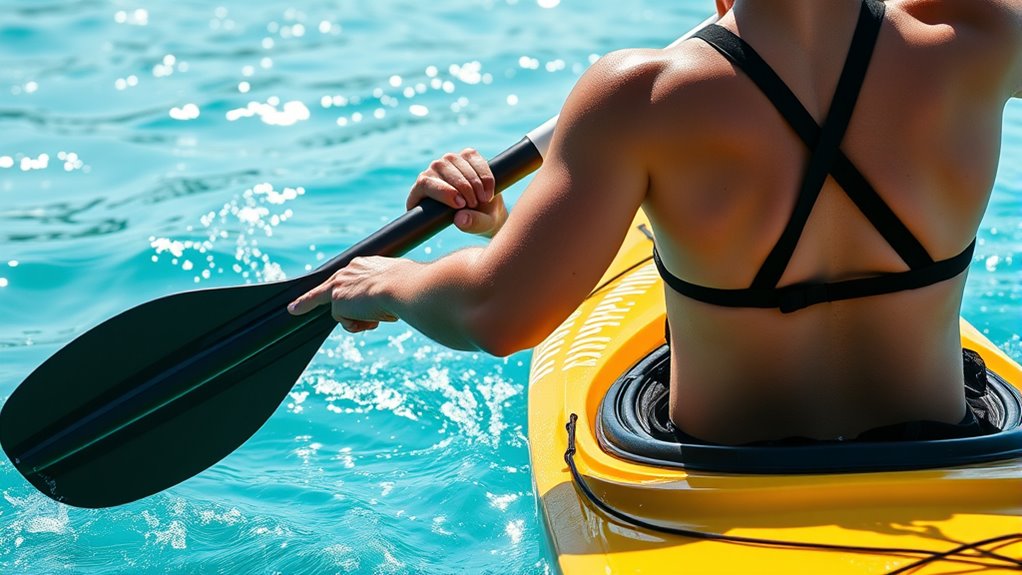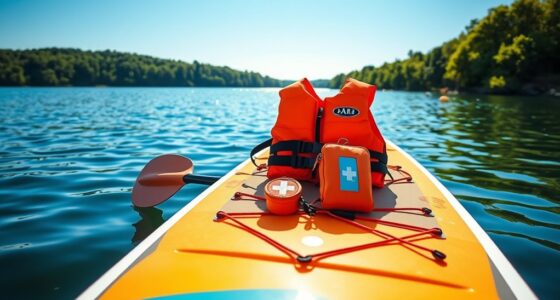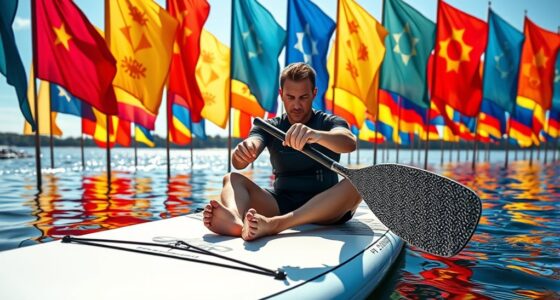Your paddle length greatly impacts your shoulder health and paddling efficiency. Using a paddle that’s too long causes overreach, putting unnecessary strain on your shoulder muscles and joints, which can lead to discomfort or injury over time. Conversely, a paddle that’s too short might restrict your reach, causing awkward movements and added tension. Finding the right size helps maintain proper posture, reduces fatigue, and keeps your shoulders happy. Keep going to discover how small adjustments can make a big difference.
Key Takeaways
- Improper paddle length causes overreaching or restricted movement, increasing shoulder strain and risking rotator cuff injuries.
- Incorrect paddle sizing disrupts natural shoulder alignment, leading to inefficient strokes and added muscular tension.
- Overly long paddles promote excessive shoulder and arm extension, elevating the risk of tendinitis and joint fatigue.
- Using the wrong paddle length forces compensatory torso movements, causing unnatural shoulder mechanics over time.
- Properly sized paddles support optimal shoulder posture, reducing repetitive strain and enhancing overall paddling comfort.

Choosing the right paddle length is essential because it directly impacts your shoulder health during paddling. When your paddle is too long or too short, you risk putting unnecessary strain on your shoulder muscles and joints, which can lead to discomfort or injury over time. A properly sized paddle promotes better posture and reduces fatigue, helping you paddle more comfortably and efficiently. One key factor in selecting the correct paddle length is ensuring that your paddle has an ergonomic grip. An ergonomic grip allows your hand to hold the paddle comfortably without overextending or twisting unnaturally, which can cause shoulder tension. When your grip feels natural, your shoulder muscles don’t have to compensate for awkward wrist or arm positions, decreasing the risk of strain.
In addition to grip comfort, stroke efficiency plays a vital role in maintaining shoulder health. A paddle that’s too long might force you to overreach, causing you to extend your arm and shoulder beyond their natural range of motion. Over time, this can lead to overuse injuries like rotator cuff strains or tendinitis. Conversely, a paddle that’s too short may restrict your reach, encouraging you to compensate by twisting your torso or leaning forward, which again puts undue stress on your shoulders and back. Finding a paddle length that aligns with your height and paddling style ensures your stroke remains smooth and efficient, minimizing unnecessary movements that could cause injury.
When you choose a paddle that fits your body properly, your paddling becomes more effective, allowing you to generate power without overexerting your shoulders. A well-sized paddle with an ergonomic grip encourages a natural paddling rhythm, reducing fatigue and improving your overall stroke efficiency. The right paddle length also helps you maintain proper shoulder alignment throughout each stroke, which is crucial for preventing repetitive strain injuries. Additionally, some paddlers benefit from proper paddle sizing, which can further enhance comfort and performance. Remember, even small adjustments in paddle length can make a significant difference in how your shoulders feel after a long day on the water.
Frequently Asked Questions
How Does Paddle Length Affect Overall Paddle Control?
Paddle length directly influences your control, affecting how easily you maneuver and grip the paddle. A longer paddle can enhance leverage, making it easier to execute powerful strokes, but may reduce maneuverability in tight spaces. An ergonomic grip ensures comfort and better control, regardless of paddle length. Ultimately, choosing the right paddle length balances maneuverability and power, helping you maintain ideal control during your paddling sessions.
Can Paddle Length Influence Paddle Durability and Lifespan?
Paddle length can influence its durability and lifespan because a longer paddle might put extra stress on joints and materials during use. With the right paddle material, it resists cracks and wear better, extending its life. Good grip ergonomics reduce strain, preventing damage from mishandling. Choosing a paddle with ideal length ensures less stress on the material and your joints, ultimately making it more durable and long-lasting.
Does Paddle Length Impact Energy Expenditure During Play?
You might find that paddle length influences your energy expenditure during play. Longer paddles can offer ergonomic benefits, helping you maintain better posture and reducing strain. This often leads to fatigue reduction, allowing you to play longer without tiring quickly. Conversely, shorter paddles can increase effort, making you work harder. Choosing the right paddle length enhances your comfort, improves efficiency, and helps conserve energy during extended matches.
Are There Specific Paddle Lengths Recommended for Beginners?
For beginners, choosing a paddle with ideal paddle ergonomics is key. A slightly shorter paddle helps develop proper beginner technique, making it easier to control and maneuver. Look for a paddle that feels comfortable in your hands, with the right weight and grip size. This approach minimizes strain and builds confidence. As you improve, you can experiment with different lengths to find what best supports your playing style and shoulder health.
How Does Paddle Length Vary Across Different Water Sports?
They say, “know your tools,” and in water sports, paddle length varies to match activity needs. You’ll see different paddle length ergonomics across water sports paddle variations—longer paddles for stand-up paddleboarding, shorter ones for kayaking or canoeing. This guarantees better control, reduces fatigue, and improves performance. Choosing the right paddle length helps you stay comfortable and efficient, no matter your water adventure.
Conclusion
Choosing the right paddle length can make all the difference in protecting your shoulder health. When you pay attention to how your paddle feels and fits, you’re less likely to push yourself to the brink and risk injury. Remember, sometimes it’s the little things that make a big difference, so don’t ignore the connection between your gear and your well-being. By staying mindful, you’ll keep your shoulders happy and paddle longer without hitting a brick wall.










